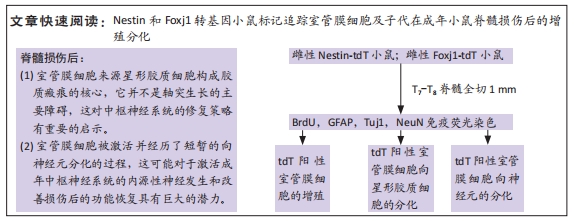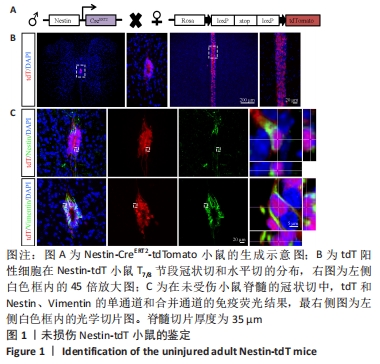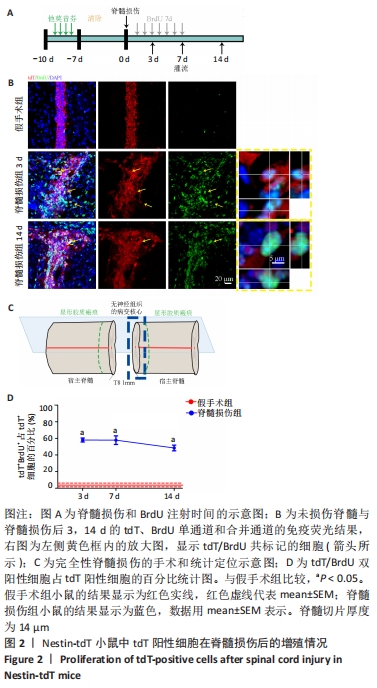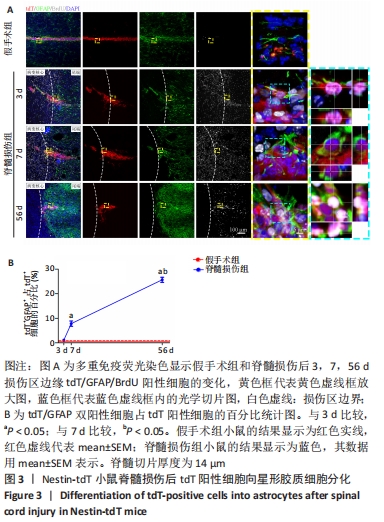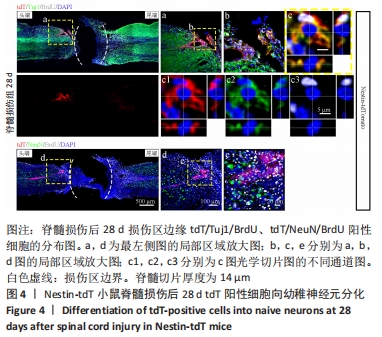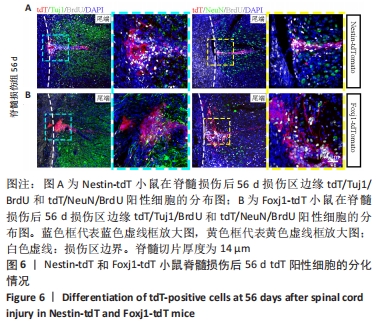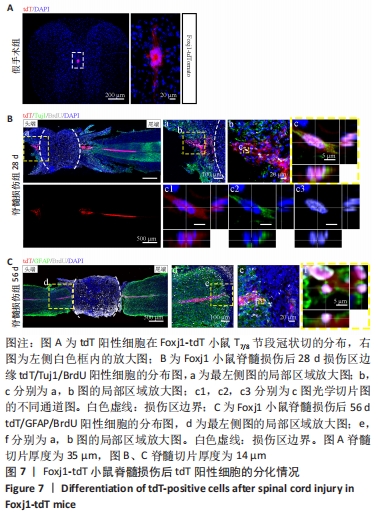[1] LEE-LIU D, EDWARDS-FARET G, TAPIA VS, et al. Spinal cord regeneration: lessons for mammals from non-mammalian vertebrates. Genesis. 2013; 51(8):529-544.
[2] LI X, FLORIDDIA EM, TOSKAS K, et al. Regenerative Potential of Ependymal Cells for Spinal Cord Injuries Over Time. EBioMedicine. 2016;13:55-65.
[3] MELETIS K, BARNABÉ-HEIDER F, CARLÉN M, et al. Spinal cord injury reveals multilineage differentiation of ependymal cells. PLoS Biol. 2008; 6(7):e182.
[4] LLORENS-BOBADILLA E, CHELL JM, LE MERRE P, et al. A latent lineage potential in resident neural stem cells enables spinal cord repair. Science. 2020;370(6512):eabb8795.
[5] 段红梅, 宋伟, 赵文, 等. 成年哺乳类脊髓损伤后的内源性神经发生[J]. 中国科学:生命科学,2016,46(12):1382-1387.
[6] BRANDA CS, DYMECKI SM. Talking about a revolution: The impact of site-specific recombinases on genetic analyses in mice. Dev Cell. 2004;6(1):7-28.
[7] MAO J, BARROW J, MCMAHON J, et al. An ES cell system for rapid, spatial and temporal analysis of gene function in vitro and in vivo. Nucleic Acids Res. 2005;33(18):e155.
[8] METZGER D, CHAMBON P. Site- and time-specific gene targeting in the mouse. Methods. 2001;24(1):71-80.
[9] SANDLESH P, JUANG T, SAFINA A, et al. Uncovering the fine print of the CreERT2-LoxP system while generating a conditional knockout mouse model of Ssrp1 gene. PLoS One. 2018;13(6):e0199785.
[10] HAYASHI S, MCMAHON AP. Efficient recombination in diverse tissues by a tamoxifen-inducible form of Cre: a tool for temporally regulated gene activation/inactivation in the mouse. Dev Biol. 2002;244(2):305-318.
[11] CARLÉN M, MELETIS K, BARNABÉ-HEIDER F, et al. Genetic visualization of neurogenesis. Exp Cell Res. 2006;312(15):2851-2859.
[12] FRISÉN J, JOHANSSON CB, TÖRÖK C, et al. Rapid, widespread, and longlasting induction of nestin contributes to the generation of glial scar tissue after CNS injury. J Cell Biol. 1995;131(2):453-464.
[13] MUTHUSAMY N, VIJAYAKUMAR A, CHENG G JR, et al. A knock-in Foxj1(CreERT2::GFP) mouse for recombination in epithelial cells with motile cilia. Genesis. 2014;52(4):350-358.
[14] BERNAL A, ARRANZ L. Nestin-expressing progenitor cells: function, identity and therapeutic implications. Cell Mol Life Sci. 2018;75(12): 2177-2195.
[15] BARNABÉ-HEIDER F, GÖRITZ C, SABELSTRÖM H, et al. Origin of new glial cells in intact and injured adult spinal cord. Cell Stem Cell. 2010; 7(4):470-482.
[16] WANNER IB, ANDERSON MA, SONG B, et al. Glial scar borders are formed by newly proliferated, elongated astrocytes that interact to corral inflammatory and fibrotic cells via STAT3-dependent mechanisms after spinal cord injury. J Neurosci. 2013;33(31):12870-12886.
[17] LI X, FLORIDDIA EM, TOSKAS K, et al. FoxJ1 regulates spinal cord development and is required for the maintenance of spinal cord stem cell potential. Exp Cell Res. 2018;368(1):84-100.
[18] DERVAN AG, ROBERTS BL. Reaction of spinal cord central canal cells to cord transection and their contribution to cord regeneration. J Comp Neurol. 2003;458(3):293-306.
[19] SABELSTRÖM H, STENUDD M, FRISÉN J. Neural stem cells in the adult spinal cord. Exp Neurol. 2014;260:44-49.
[20] YU SS, LI ZY, XU XZ, et al. M1-type microglia can induce astrocytes to deposit chondroitin sulfate proteoglycan after spinal cord injury. Neural Regen Res. 2022;17(5):1072-1079.
[21] CREGG JM, DEPAUL MA, FILOUS AR, et al. Functional regeneration beyond the glial scar. Exp Neurol. 2014;253:197-207.
[22] BUSCH SA, SILVER J. The role of extracellular matrix in CNS regeneration. Curr Opin Neurobiol. 2007;17(1):120-127.
[23] KAWAGUCHI A, MIYATA T, SAWAMOTO K, et al. Nestin-EGFP transgenic mice: visualization of the self-renewal and multipotency of CNS stem cells. Mol Cell Neurosci. 2001;17(2):259-273.
[24] DULIN JN, ADLER AF, KUMAMARU H, et al. Injured adult motor and sensory axons regenerate into appropriate organotypic domains of neural progenitor grafts. Nat Commun. 2018;9(1):84.
[25] YANG Z, ZHANG A, DUAN H, et al. NT3-chitosan elicits robust endogenous neurogenesis to enable functional recovery after spinal cord injury. Proc Natl Acad Sci U S A. 2015;112(43):13354-13359.
[26] WALKER CL, FRY CME, WANG J, et al. Functional and Histological Gender Comparison of Age-Matched Rats after Moderate Thoracic Contusive Spinal Cord Injury. J Neurotrauma. 2019;36(12):1974-1984.
[27] FUKUTOKU T, KUMAGAI G, FUJITA T, et al. Sex-Related Differences in Anxiety and Functional Recovery after Spinal Cord Injury in Mice. J Neurotrauma. 2020;37(21):2235-2243.
[28] BAINE RE, JOHNSTON DT, STRAIN MM, et al. Noxious Stimulation Induces Acute Hemorrhage and Impairs Long-Term Recovery after Spinal Cord Injury (SCI) in Female Rats: Evidence Estrous Cycle May Have a Modulatory Effect. Neurotrauma Rep. 2022;3(1):70-86.
[29] REN Y, AO Y, O’SHEA TM, et al. Ependymal cell contribution to scar formation after spinal cord injury is minimal, local and dependent on direct ependymal injury. Sci Rep. 2017;7:41122.
[30] SABELSTRÖM H, STENUDD M, RÉU P, et al. Resident neural stem cells restrict tissue damage and neuronal loss after spinal cord injury in mice. Science. 2013;342(6158):637-640.
[31] MOTHE AJ, TATOR CH. Proliferation, migration, and differentiation of endogenous ependymal region stem/progenitor cells following minimal spinal cord injury in the adult rat. Neuroscience. 2005;131(1):177-187.
[32] HU J, JIN LQ, SELZER ME. Inhibition of central axon regeneration: perspective from chondroitin sulfate proteoglycans in lamprey spinal cord injury. Neural Regen Res. 2022;17(9):1955-1956.
[33] ANDERSON MA, BURDA JE, REN Y, et al. Astrocyte scar formation aids central nervous system axon regeneration. Nature. 2016;532(7598): 195-200.
[34] LU P, KADOYA K, TUSZYNSKI MH. Axonal growth and connectivity from neural stem cell grafts in models of spinal cord injury. Curr Opin Neurobiol. 2014;27:103-109.
[35] MA D, ZHAO Y, HUANG L, et al. A novel hydrogel-based treatment for complete transection spinal cord injury repair is driven by microglia/macrophages repopulation. Biomaterials. 2020;237:119830.
[36] YANG Z, DUAN H, MO L, et al. The effect of the dosage of NT-3/chitosan carriers on the proliferation and differentiation of neural stem cells. Biomaterials. 2010;31(18):4846-4854.
[37] NORISTANI HN, SABOURIN JC, BOUKHADDAOUI H, et al. Spinal cord injury induces astroglial conversion towards neuronal lineage. Mol Neurodegener. 2016;11(1):68.
[38] GUO Y, LIU S, ZHANG X, et al. Sox11 promotes endogenous neurogenesis and locomotor recovery in mice spinal cord injury. Biochem Biophys Res Commun. 2014;446(4):830-835.
[39] YANG L, LI G, YE J, et al. Substance P enhances endogenous neurogenesis to improve functional recovery after spinal cord injury. Int J Biochem Cell Biol. 2017;89:110-119.
|
